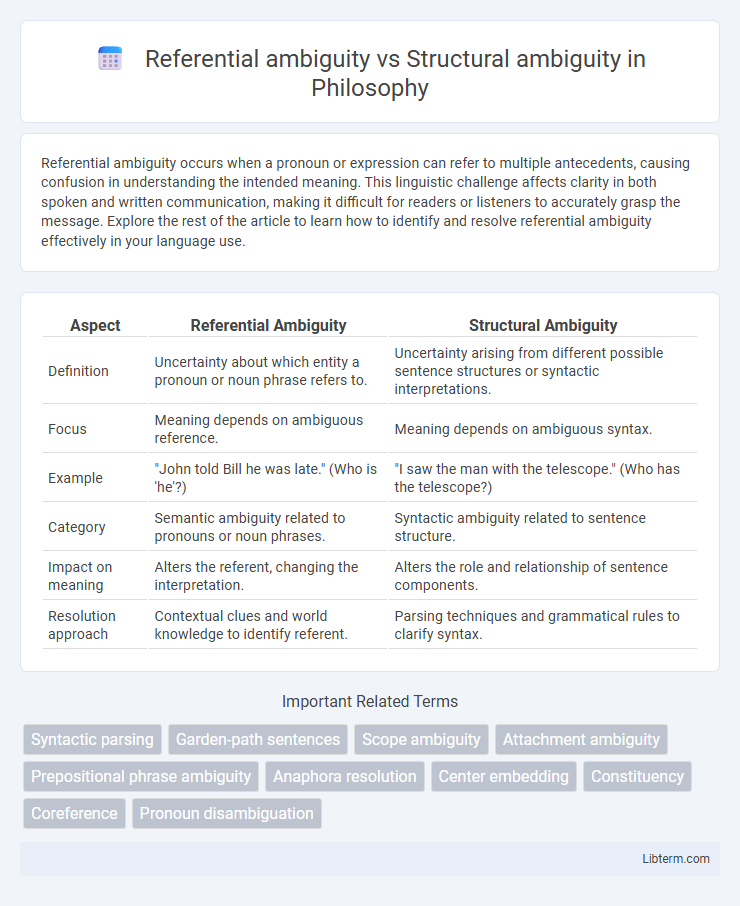Referential ambiguity occurs when a pronoun or expression can refer to multiple antecedents, causing confusion in understanding the intended meaning. This linguistic challenge affects clarity in both spoken and written communication, making it difficult for readers or listeners to accurately grasp the message. Explore the rest of the article to learn how to identify and resolve referential ambiguity effectively in your language use.
Table of Comparison
| Aspect | Referential Ambiguity | Structural Ambiguity |
|---|---|---|
| Definition | Uncertainty about which entity a pronoun or noun phrase refers to. | Uncertainty arising from different possible sentence structures or syntactic interpretations. |
| Focus | Meaning depends on ambiguous reference. | Meaning depends on ambiguous syntax. |
| Example | "John told Bill he was late." (Who is 'he'?) | "I saw the man with the telescope." (Who has the telescope?) |
| Category | Semantic ambiguity related to pronouns or noun phrases. | Syntactic ambiguity related to sentence structure. |
| Impact on meaning | Alters the referent, changing the interpretation. | Alters the role and relationship of sentence components. |
| Resolution approach | Contextual clues and world knowledge to identify referent. | Parsing techniques and grammatical rules to clarify syntax. |
Introduction to Ambiguity in Language
Referential ambiguity occurs when a pronoun or noun phrase can refer to multiple entities within a sentence, causing uncertainty about the intended reference. Structural ambiguity arises from the sentence's syntactic arrangement, leading to multiple possible interpretations due to different groupings of words or phrases. Understanding these types of ambiguity is critical for natural language processing and improving clarity in communication.
Defining Referential Ambiguity
Referential ambiguity occurs when a pronoun or expression can refer to more than one antecedent in a sentence, causing uncertainty about its exact meaning. This type of ambiguity differs from structural ambiguity, which arises from multiple possible syntactic interpretations of a sentence's structure. An example of referential ambiguity is in the sentence "John told Bill that he was late," where "he" could refer to either John or Bill.
Understanding Structural Ambiguity
Structural ambiguity arises when a sentence can be parsed in multiple ways due to its syntactic structure, leading to different interpretations. This type of ambiguity contrasts with referential ambiguity, which occurs when it is unclear to which entity a pronoun or noun phrase refers. Understanding structural ambiguity involves analyzing sentence components and their hierarchical relationships, such as phrase attachment or coordination scope, to resolve potential multiple meanings.
Key Differences Between Referential and Structural Ambiguity
Referential ambiguity arises when a pronoun or noun phrase can refer to multiple antecedents, creating uncertainty about the intended reference. Structural ambiguity occurs when a sentence's syntax allows multiple possible interpretations due to different phrase attachments or scope relations. The key difference lies in referential ambiguity involving unclear antecedent references, while structural ambiguity stems from multiple syntactic parses generating varied meanings.
Causes of Referential Ambiguity
Referential ambiguity arises when a pronoun or noun phrase can refer to multiple antecedents within a sentence or context, causing confusion about the intended referent. It often occurs due to vague or insufficient contextual cues, improper sentence construction, or the presence of multiple potential antecedents with similar salience. Understanding these causes is crucial for resolving ambiguity in natural language processing and improving clarity in communication.
Causes of Structural Ambiguity
Structural ambiguity arises from the syntactic arrangement of words, where multiple possible sentence structures lead to different interpretations. Causes include unclear attachment of modifiers, coordination ambiguity between conjunctions, and ambiguous phrase boundaries. This type of ambiguity often occurs in sentences with complex noun phrases or prepositional phrases that can attach to different parts of the sentence.
Real-world Examples of Referential Ambiguity
Referential ambiguity occurs when a pronoun or noun phrase can refer to multiple possible antecedents, such as in the sentence "John told Mike that he won the prize," where "he" could refer to either John or Mike. Structural ambiguity arises from the sentence's syntax, as seen in "I saw the man with the telescope," which can mean either the observer used a telescope or the man possessed one. Real-world examples of referential ambiguity frequently appear in legal documents, where unclear pronoun references can lead to misinterpretation of clauses and responsibilities.
Real-world Examples of Structural Ambiguity
Structural ambiguity occurs when a sentence's syntax allows multiple interpretations, such as "I saw the man with the telescope," which can mean either using a telescope to see the man or seeing a man who has a telescope. Real-world examples include headlines like "Flying planes can be dangerous," where it's unclear whether planes are flying or if flying them is dangerous, and "Visiting relatives can be annoying," which could mean relatives who visit or the act of visiting relatives. These ambiguities highlight the importance of clear sentence structure to avoid misinterpretation in communication and language processing.
Implications in Communication and Interpretation
Referential ambiguity arises when a pronoun or noun phrase can refer to multiple possible antecedents, causing confusion in identifying the intended subject, which complicates clear communication. Structural ambiguity occurs from sentence syntax that allows multiple interpretations of meaning, affecting comprehension and precise message delivery. Both types of ambiguity impact interpretation by creating uncertainty that hinders effective communication and may lead to misunderstanding in discourse analysis and natural language processing applications.
Strategies to Resolve Language Ambiguities
Referential ambiguity occurs when it is unclear which entity a pronoun or noun phrase refers to, while structural ambiguity arises from multiple possible syntactic interpretations of a sentence. Strategies to resolve these ambiguities include context analysis, where surrounding text clarifies meaning, and syntactic parsing techniques, which use grammatical rules to determine the intended structure. Machine learning models and semantic role labeling also improve disambiguation by leveraging large datasets and understanding relationships between sentence elements.
Referential ambiguity Infographic

 libterm.com
libterm.com